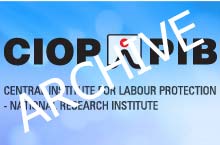A Design of Experiments for Statistically Predicting Risk of Adverse Health Effects on Drivers Exposed to Vertical Vibrations
|
"International Journal of Occupational Safety and Ergonomics" 3/2011, p. 221-232
Houcine Ayari, Marc Thomas, Sylvie Doré
|

|
An injury risk factor (IRF), which indicates the risk of adverse health effect to lumbar rachis arising from mechanical vibrations, is developed. Experiments have been conducted that consider acceleration levels at the seat of drivers, posture, morphology, density, damping rate and body mass as independent variables. A parametric finite-element model of the lumbar rachis has been generated. It is shown that the IRF increases with ageing and an IRF of 30% is proposed as a threshold for fatigue purposes. This level is reached if a peak acceleration level greater than 3 m/s² is applied to a light (55 kg) and an old driver with a low bone density and a damping rate of 20%. This vibration threshold must be reduced to 2.7 m/s² if the driver’s weight increases to 75 kg and to 2 m/s² if the driver is heavy (98 kg).
Examining the Effectiveness of Anti-Vibration Gloves With a Neural Network
|
"International Journal of Occupational Safety and Ergonomics" 3/2011, p. 241-247
|

|
Whether anti-vibration gloves are effective in protecting against vibrations depends not only on the materials they are made of, but also on the parameters of the source of vibration. Depending on those parameters, the effectiveness of the same means of protection may be radically different. This article presents a methodology of using a neural network to test anti-vibration gloves. A network can map gloves in various conditions, i.e., for vibrations of various amplitudes and spectra, and for various forces exerted by the worker on a tool. Real, measured vibration signals produced by different tools were used in training a neural network. The results presented in this article prove that real properties of gloves are accurately represented by their models developed as a result of training a neural network.
|









